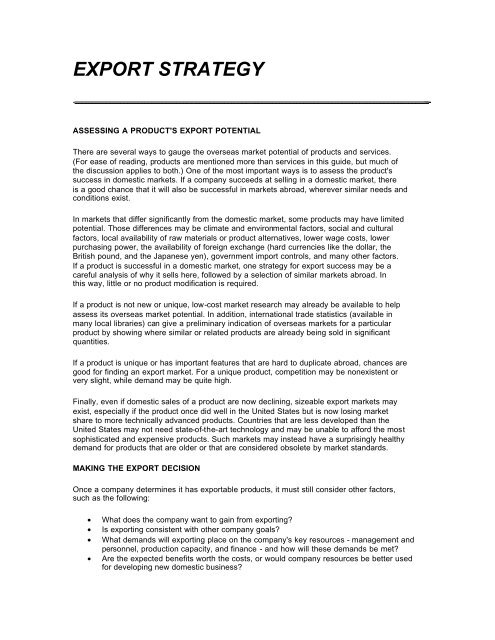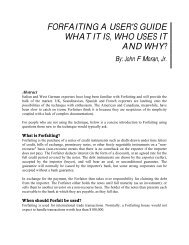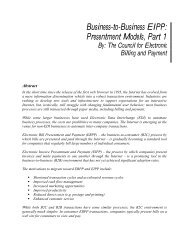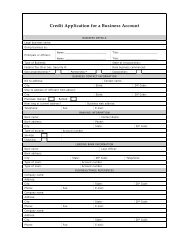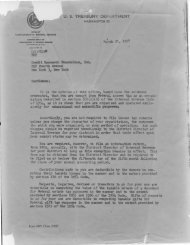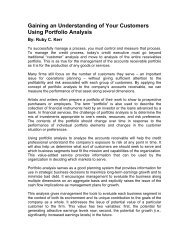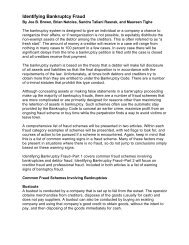Developing an Export Strategy
Developing an Export Strategy
Developing an Export Strategy
You also want an ePaper? Increase the reach of your titles
YUMPU automatically turns print PDFs into web optimized ePapers that Google loves.
EXPORT STRATEGYASSESSING A PRODUCT'S EXPORT POTENTIALThere are several ways to gauge the overseas market potential of products <strong>an</strong>d services.(For ease of reading, products are mentioned more th<strong>an</strong> services in this guide, but much ofthe discussion applies to both.) One of the most import<strong>an</strong>t ways is to assess the product'ssuccess in domestic markets. If a comp<strong>an</strong>y succeeds at selling in a domestic market, thereis a good ch<strong>an</strong>ce that it will also be successful in markets abroad, wherever similar needs <strong>an</strong>dconditions exist.In markets that differ signific<strong>an</strong>tly from the domestic market, some products may have limitedpotential. Those differences may be climate <strong>an</strong>d environmental factors, social <strong>an</strong>d culturalfactors, local availability of raw materials or product alternatives, lower wage costs, lowerpurchasing power, the availability of foreign exch<strong>an</strong>ge (hard currencies like the dollar, theBritish pound, <strong>an</strong>d the Jap<strong>an</strong>ese yen), government import controls, <strong>an</strong>d m<strong>an</strong>y other factors.If a product is successful in a domestic market, one strategy for export success may be acareful <strong>an</strong>alysis of why it sells here, followed by a selection of similar markets abroad. Inthis way, little or no product modification is required.If a product is not new or unique, low-cost market research may already be available to helpassess its overseas market potential. In addition, international trade statistics (available inm<strong>an</strong>y local libraries) c<strong>an</strong> give a preliminary indication of overseas markets for a particularproduct by showing where similar or related products are already being sold in signific<strong>an</strong>tqu<strong>an</strong>tities.If a product is unique or has import<strong>an</strong>t features that are hard to duplicate abroad, ch<strong>an</strong>ces aregood for finding <strong>an</strong> export market. For a unique product, competition may be nonexistent orvery slight, while dem<strong>an</strong>d may be quite high.Finally, even if domestic sales of a product are now declining, sizeable export markets mayexist, especially if the product once did well in the United States but is now losing marketshare to more technically adv<strong>an</strong>ced products. Countries that are less developed th<strong>an</strong> theUnited States may not need state-of-the-art technology <strong>an</strong>d may be unable to afford the mostsophisticated <strong>an</strong>d expensive products. Such markets may instead have a surprisingly healthydem<strong>an</strong>d for products that are older or that are considered obsolete by market st<strong>an</strong>dards.MAKING THE EXPORT DECISIONOnce a comp<strong>an</strong>y determines it has exportable products, it must still consider other factors,such as the following:• What does the comp<strong>an</strong>y w<strong>an</strong>t to gain from exporting?• Is exporting consistent with other comp<strong>an</strong>y goals?• What dem<strong>an</strong>ds will exporting place on the comp<strong>an</strong>y's key resources - m<strong>an</strong>agement <strong>an</strong>dpersonnel, production capacity, <strong>an</strong>d fin<strong>an</strong>ce - <strong>an</strong>d how will these dem<strong>an</strong>ds be met?• Are the expected benefits worth the costs, or would comp<strong>an</strong>y resources be better usedfor developing new domestic business?
Answers to these questions c<strong>an</strong> help a comp<strong>an</strong>y not only decide whether or not to export butalso determine what methods of exporting should be initially used.THE VALUE OF PLANNINGM<strong>an</strong>y comp<strong>an</strong>ies begin export activities haphazardly, without carefully screening markets oroptions for market entry. While these comp<strong>an</strong>ies may or may not have a measure of success,they may overlook better export opportunities.In the event that early export efforts are unsuccessful because of poor pl<strong>an</strong>ning, the comp<strong>an</strong>ymay even be misled into ab<strong>an</strong>doning exporting altogether.Formulating <strong>an</strong> export strategy based on good information <strong>an</strong>d proper assessment increasesthe ch<strong>an</strong>ces that the best options will be chosen, that resources will be used effectively, <strong>an</strong>dthat efforts will consequently be carried through to completion.The purposes of the export pl<strong>an</strong> are, first, to assemble facts, constraints, <strong>an</strong>d goals <strong>an</strong>d,second, to create <strong>an</strong> action statement that takes all of these into account. The statementincludes specific objectives; it sets forth time schedules for implementation; <strong>an</strong>d it marksmilestones so that the degree of success c<strong>an</strong> be measured <strong>an</strong>d help motivate personnel.The first draft of the export pl<strong>an</strong> may be quite short <strong>an</strong>d simple, but it should become moredetailed <strong>an</strong>d complete as the pl<strong>an</strong>ners learn more about exporting <strong>an</strong>d their comp<strong>an</strong>y'scompetitive position. At least the following ten questions should ultimately be addressed:1. What products are selected for export development? What modifications, if <strong>an</strong>y, mustbe made to adapt them for overseas markets?2. What countries are targeted for sales development?3. In each country, what is the basic customer profile? What marketing <strong>an</strong>d distributionch<strong>an</strong>nels should be used to reach customers?4. What special challenges pertain to each market (competition, cultural differences,import controls, etc.), <strong>an</strong>d what strategy will be used to address them?5. How will the product's export sales price be determined?6. What specific operational steps must be taken <strong>an</strong>d when?7. What will be the time frame for implementing each element of the pl<strong>an</strong>?8. What personnel <strong>an</strong>d comp<strong>an</strong>y resources will be dedicated to exporting?9. What will be the cost in time <strong>an</strong>d money for each element?10. How will results be evaluated <strong>an</strong>d used to modify the pl<strong>an</strong>?One key to developing a successful pl<strong>an</strong> is the participation of all personnel who will beinvolved in the exporting process. All aspects of <strong>an</strong> export pl<strong>an</strong> should be agreed upon bythose who will ultimately execute them.A clearly written marketing strategy offers six immediate benefits:1. Because written pl<strong>an</strong>s display their strengths <strong>an</strong>d weaknesses more readily, they areof great help in formulating <strong>an</strong>d polishing <strong>an</strong> export strategy.2. Written pl<strong>an</strong>s are not as easily forgotten, overlooked, or ignored by those charged withexecuting them. If deviation from the original pl<strong>an</strong> occurs, it is likely to be due to adeliberate choice to do so.3. Written pl<strong>an</strong>s are easier to communicate to others <strong>an</strong>d are less likely to bemisunderstood.4. Written pl<strong>an</strong>s allocate responsibilities <strong>an</strong>d provide for <strong>an</strong> evaluation of results.
5. Written pl<strong>an</strong>s c<strong>an</strong> be of help in seeking fin<strong>an</strong>cing. They indicate to lenders a seriousapproach to the export venture.6. Written pl<strong>an</strong>s give m<strong>an</strong>agement a clear underst<strong>an</strong>ding of what will be required <strong>an</strong>dthus help to ensure a commitment to exporting. In fact, a written pl<strong>an</strong> signals thatthe decision to export has already been made.This last adv<strong>an</strong>tage is especially noteworthy. Building <strong>an</strong> international business takes time; itis usually months, sometimes even several years, before <strong>an</strong> exporting comp<strong>an</strong>y begins to seea return on its investment of time <strong>an</strong>d money. By committing to the specifics of a written pl<strong>an</strong>,top m<strong>an</strong>agement c<strong>an</strong> make sure that the firm will finish what it begins <strong>an</strong>d that the hopes thatprompted its export efforts will be fulfilled.THE PLANNING PROCESS AND THE RESULTA crucial first step in pl<strong>an</strong>ning is to develop broad consensus among key m<strong>an</strong>agement on thecomp<strong>an</strong>y's goals, objectives, capabilities, <strong>an</strong>d constraints.The first time <strong>an</strong> export pl<strong>an</strong> is developed, it should be kept simple. It need be only a fewpages long, since import<strong>an</strong>t market data <strong>an</strong>d pl<strong>an</strong>ning elements may not yet be available.The initial pl<strong>an</strong>ning effort itself gradually generates more information <strong>an</strong>d insight that c<strong>an</strong> beincorporated into more sophisticated pl<strong>an</strong>ning documents later.From the start, the pl<strong>an</strong> should be viewed <strong>an</strong>d written as a m<strong>an</strong>agement tool, not as a staticdocument. For inst<strong>an</strong>ce, objectives in the pl<strong>an</strong> should be compared with actual results as ameasure of the success of different strategies. Furthermore, the comp<strong>an</strong>y should not hesitateto modify the pl<strong>an</strong> <strong>an</strong>d make it more specific as new information <strong>an</strong>d experience are gained.A detailed pl<strong>an</strong> is recommended for comp<strong>an</strong>ies that intend to export directly.Comp<strong>an</strong>ies choosing indirect export methods may require much simpler pl<strong>an</strong>s.APPROACHES TO EXPORTINGThe way a comp<strong>an</strong>y chooses to export its products c<strong>an</strong> have a signific<strong>an</strong>t effect on its exportpl<strong>an</strong> <strong>an</strong>d specific marketing strategies. The basic distinction among approaches to exportingrelates to a comp<strong>an</strong>y's level of involvement in the export process. There are at least fourapproaches, which may be used alone or in combination:1. Passively filling orders from domestic buyers who then export the product.These sales are indistinguishable from other domestic sales as far as the original selleris concerned. Someone else has decided that the product in question meets foreigndem<strong>an</strong>d. That party takes all the risk <strong>an</strong>d h<strong>an</strong>dles all of the exporting details, in somecases without even the awareness of the original seller.(M<strong>an</strong>y comp<strong>an</strong>ies take a stronger interest in exporting when they discover that theirproduct is already being sold overseas.)2. Seeking out domestic buyers who represent foreign end users or customers.M<strong>an</strong>y foreign corporations, general contractors, foreign trading comp<strong>an</strong>ies, foreigngovernment agencies, foreign distributors <strong>an</strong>d retailers, <strong>an</strong>d domestic comp<strong>an</strong>ies aswell purchase for export. These buyers are a large market for a wide variety of goods<strong>an</strong>d services. In this case a comp<strong>an</strong>y may know its product is being exported, but itis still the buyer who assumes the risk <strong>an</strong>d h<strong>an</strong>dles the details of exporting.3. <strong>Export</strong>ing indirectly through intermediaries.With this approach, a comp<strong>an</strong>y engages the services of <strong>an</strong> intermediary firm capableof finding foreign markets <strong>an</strong>d buyers for its products. <strong>Export</strong> m<strong>an</strong>agement comp<strong>an</strong>ies
(EMCs), export trading comp<strong>an</strong>ies (ETCs), international trade consult<strong>an</strong>ts, <strong>an</strong>d otherintermediaries c<strong>an</strong> give the exporter access to well-established expertise <strong>an</strong>d tradecontacts. Yet, the exporter c<strong>an</strong> still retain considerable control over the process <strong>an</strong>dc<strong>an</strong> realize some of the other benefits of exporting, such as learning more about foreigncompetitors, new technologies, <strong>an</strong>d other market opportunities.4. <strong>Export</strong>ing directly.This approach is the most ambitious <strong>an</strong>d difficult, since the exporter personally h<strong>an</strong>dlesevery aspect of the exporting process from market research <strong>an</strong>d pl<strong>an</strong>ning to foreigndistribution <strong>an</strong>d collections. Consequently, a signific<strong>an</strong>t commitment of m<strong>an</strong>agementtime <strong>an</strong>d attention is required to achieve good results. However, this approach may alsobe the best way to achieve maximum profits <strong>an</strong>d long-term growth. With appropriate help<strong>an</strong>d guid<strong>an</strong>ce from the Department of Commerce, state trade offices, freight forwarders,international b<strong>an</strong>ks, <strong>an</strong>d other service groups, even small or medium-sizedfirms, c<strong>an</strong> export directly if they are able to commit enough staff time to the effort.For those who c<strong>an</strong>not make that commitment, the services of <strong>an</strong> EMC, ETC, tradeconsult<strong>an</strong>t, or other qualified intermediary are indispensable.If the nature of the comp<strong>an</strong>y's goals <strong>an</strong>d resources makes <strong>an</strong> indirect method of exporting thebest choice, little further pl<strong>an</strong>ning may be needed. In such a case, the main task is to find asuitable intermediary firm that c<strong>an</strong> then h<strong>an</strong>dle most export details.Firms that are new to exporting or are unable to commit staff <strong>an</strong>d funds to more complexexport activities may find indirect methods of exporting more appropriate.Using <strong>an</strong> EMC or other intermediary, however, does not exclude all possibility of directexporting for the firm. An exporter may also choose to gradually increase its level of directexporting later, after experience has been gained <strong>an</strong>d sales volume appears to justify addedinvestment.Get more information or data on different approaches to exporting <strong>an</strong>d their adv<strong>an</strong>tages <strong>an</strong>ddisadv<strong>an</strong>tages. Consulting advisers before making these decisions c<strong>an</strong> be helpful.M<strong>an</strong>agement Issues Involved in the <strong>Export</strong> DecisionM<strong>an</strong>agement objectives• What are the comp<strong>an</strong>y's reasons for pursuing export markets? Are they solid objectives(e.g., increasing sales volume or developing a broader, more stable customer base) orare they frivolous (e.g., the owner w<strong>an</strong>ts <strong>an</strong> excuse to travel)?• How committed is top m<strong>an</strong>agement to <strong>an</strong> export effort? Is exporting viewed as a quickfix for a slump in domestic sales? Will the comp<strong>an</strong>y neglect its export customers ifdomestic sales pick up?• What are m<strong>an</strong>agement's expectations for the export effort?How quickly does m<strong>an</strong>agement expect export operations to become self-sustaining?What level of return on investment is expected from the export program?Experience• With what countries has business already been conducted, or from what countrieshave inquiries already been received?• Which product lines are mentioned most often?
• Are <strong>an</strong>y domestic customers buying the product for sale or shipment overseas?If so, to what countries?• Is the trend of sales <strong>an</strong>d inquiries up or down?• Who are the main domestic <strong>an</strong>d foreign competitors?• What general <strong>an</strong>d specific lessons have been learned from past export attempts orexperiences?M<strong>an</strong>agement <strong>an</strong>d personnel• What in-house international expertise does the firm have (international sales experience,l<strong>an</strong>guage capabilities, etc.)?• Who will be responsible for the export department's org<strong>an</strong>ization <strong>an</strong>d staff?• How much senior m<strong>an</strong>agement time (a) should be allocated <strong>an</strong>d (b) could be allocated?• What org<strong>an</strong>izational structure is required to ensure that export sales are adequatelyserviced?• Who will follow through after the pl<strong>an</strong>ning is done?Production capacity• How is the present capacity being used?• Will filling export orders hurt domestic sales?• What will be the cost of additional production?• Are there fluctuations in the <strong>an</strong>nual work load? When? Why?• What minimum order qu<strong>an</strong>tity is required?• What would be required to design <strong>an</strong>d package products specifically for export?Fin<strong>an</strong>cial capacity• What amount of capital c<strong>an</strong> be committed to export production <strong>an</strong>d marketing?• What level of export department operating costs c<strong>an</strong> be supported?• How are the initial expenses of export efforts to be allocated?• What other new development pl<strong>an</strong>s are in the works that may compete with exportpl<strong>an</strong>s?• By what date must <strong>an</strong> export effort pay for itself?


